One can safely say that the majority of pre-revolution Orthodox Churches in Ethiopia were constructed with Imperial, Royal or Noble patronage. Every Emperor, King, Prince and Nobleman, along with their wives and daughters found it to be their duty to consecrate, fund and support during their lives, and in their legacies, churches dedicated to various saints. Since the revolution of 1974, there has been an explosion of church building that has been supported by the public at large, even in the face of the official atheism of the Communist Derg Regime that ruled Ethiopia from 1974 to 1991. Although a vast number of churches in Ethiopia can legitimately claim an "Imperial" title because of links to various monarchs, there are certain churches that played an especially significant role in the life of the monarchy, and this page is dedicated to these churches.
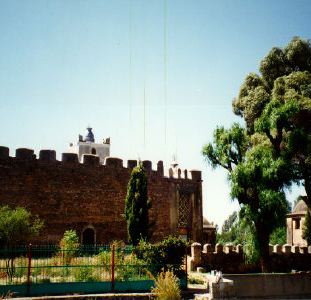 View of Old Cathedral of St. Mary of Zion
View of Old Cathedral of St. Mary of Zion
This is reputed to be the oldest church in Ethiopia, consecrated by the first Christian co-rulers, the brothers Abreha and Atsbeha (Emperors Ezana and Shezana, in the 4th century. The original cathedral is said to have had twelve altars, the High Altar dedicated to St. Mary of Zion. The Virgin Mary is accorded the title "Eternal Queen of Ethiopia" and as such, this church was and is considered the highest ranking and holiest site in Ethiopia. Ethiopian tradition maintains that Emperor Ezana (Abreha) brought the original Ark of the Covenant from the Island of Tana Kirkos to Axum and housed it in this Cathedral. It was removed from this church only a few times to protect it from invaders. It was here that all Ethiopian Emperors were expected to come to receive their anointing and coronation at the hands of the Egyptian Coptic Bishop. Even monarchs who were crowned elsewhere, were expected to come to Axum later and pay homage to the shrine in order for their coronations to have legitimacy. The original basilica was burned to the ground by Yodit Gudit in her quest to destroy Christian Axum, and seize the Ark of the Covenant. The Church was rebuilt on a smaller scale much later, but was again burned to the ground by Ahmed Ibn al Ghazi (Gragn) in the 16th Century. The Portuguese Priest Fr. Alvarez visiting in the early 16th century described this later building as a good sized church with five naves and of impressive size and grandeur. A new smaller church replacing it was built by Emperor Gelawdiwos and expanded by Emperor Minas. Then in the early 17th century, the Cathedral was completely re-built by Emperor Fasiledes, and it is this structure that survives today.
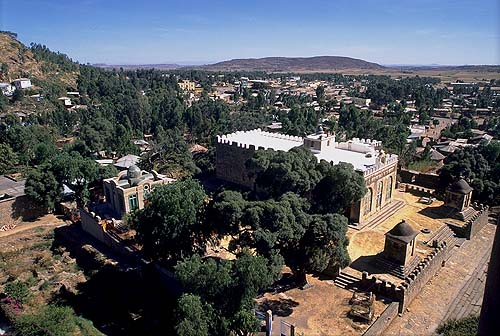 An aerial view of the Old Cathedral of St. Mary of Zion, with the Sanctuary Chapel of the Arc of the Covenant in the upper left side of the cathedral
An aerial view of the Old Cathedral of St. Mary of Zion, with the Sanctuary Chapel of the Arc of the Covenant in the upper left side of the cathedral
In 1955, to mark his Silver Jubilee, Emperor Haile Selassie laid the cornerstone of a new modern Cathedral of St. Mary of Zion next to the old Cathedral. The new Cathedral was completed in 1964. Unlike the old cathedral, the new cathedral allowed entrance to women. It was built in a modern interpretation of the Greek Byzantine style with an Ethiopian influence.
 The New Cathedral of St. Mary of Zion
The New Cathedral of St. Mary of Zion Between the old and new Cathedrals of St. Mary of Zion (both of which remain in use to this day)the Emperor's wife, Empress Menen, also built a sanctuary chapel in which is housed the Ark of the Covenant. It is guarded by a guardian monk who lives there, and cannot leave the small yard around the chapel. The guardian monk holds this position for life, and is the only person permitted to enter the chapel. He appoints his successor. The completion of the new Cathedral was of such importance that Emperor Haile Selassie attended the dedication of the Cathedral, interrupting the state visit to Ethiopia of Elizabeth II of Great Britain. The British Queen visited St. Mary of Zion a few days later.
 The Sactuary Chapel of the Arc of the Covenant at Axum
The Sactuary Chapel of the Arc of the Covenant at Axum
St. Mary of Zion was traditionally presided over by a clergyman (usually a married cleric as opposed to a monk) who held the title of Nebre-Id. The Nebre-Id of Axum not only ran the affairs of the Monastery, but was considered the temporal official incharge of administering the town of Axum and it's dependencies. The title of Nebre-Id was considered equal to that of Ras (Duke), and in fact, if the dignity of Ras Werq (the right to wear a coronet) was included, it outranked the title of Ras. Although a clerical title, it was bestowed by the Emperor rather than the Archbishop (later Patriarch) and was directly responsible to the throne. Subsequent to the revolution of 1974, the right to appoint the Nebre-Id was taken over by the Patriarchate. The title became purely ecclesiastical as the town of Axum was henceforth administered by a mayor. Then in 1999, following a special decision of the Holy Synod, Axum was elevated to the rank of Archdiocese, and the title of Archbishop of Axum was reserved for the Patriarch of Ethiopia himself, as it was the seat of the very first Bishop of Ethiopia, Abune Selamma Kesate Birhan (St. Frementius of the Ethiopians). Day to day administration of the diocese however is handled by an auxiliary bishop. Those who held the title of Nebre-Id carried it for life, and continue to do so. The Cathedral Monastery of St. Mary of Zion carries the title "Re-ese Adbarat" or First among the Monasteries, giving it the highest rank of the Ethiopian Orthodox Church. It is the burial place of Emperor Yohannis IV and his descendants. Both the new Cathedral and the Sanctuary Chapel show some considerable dilapidation due to years of Axum being in the area of conflict during Ethiopia's long civil war.
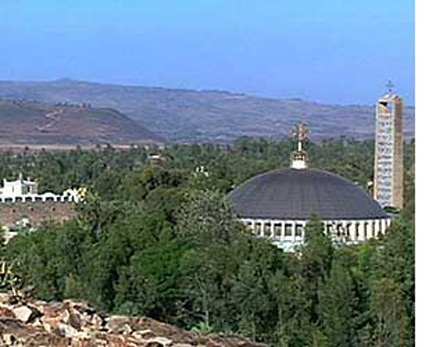 Airial view of the New Cathedral in its glory circa 1970's
Airial view of the New Cathedral in its glory circa 1970's
Menbere Tseba-ot, Aga-iste Alem, Kidist Selassie (Altar of Purity, Sovereigns of the World Holy Trinity Cathedral)Addis Ababa
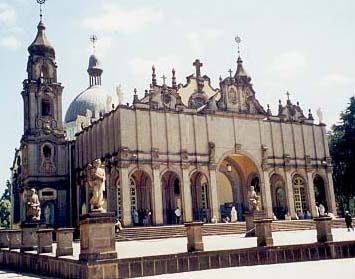
Holy Trinity Cathedral is the considered the second highest ranking place of worship in Ethiopia, and the highest ranking of Addis Ababa's 5 Orthodox Cathedrals. (The other Cathedrals are the Imperial era St. George in the Arada district, and the post-revolution era Debre Gellila Emanuel Cathedral and the St. Michael Cathedral in the Merkato district, and the huge Savior of the World Cathedral being in the Bole district of the City). Holy Trinity Cathedral is located next to the Parliament Building near the Arat Kilo (Meyazia 27)Square which is the government sector of the City of Addis Ababa. The original Church of the Holy Trinity was established by Emperor Menelik II soon after he moved his capital from Mt. Entoto to Addis Ababa. The original church, known as the Mekane Selassie (House of the Trinity) Monastery, built of wood with intricate carvings, was constructed with the help of wood workers and carvers from India. Within sight of the Imperial Palace, it was visited frequently by the Imperial family. Then in 1928, a cornerstone was laid by Empress Zewditu for a new Cathedral to be built. Work progressed slowly, and was halted during the Italian occupation of 1936 to 1941. The new Cathedral would not be completed until 1942, after the return from exile of Emperor Haile Selassie following the Italian occupation. Holy Trinity serves as the burial ground for the patriots who fought against the Italians both inside the country and in exile. No other persons, other than high clergy, are allowed to be buried on the grounds of the Cathedral itself (although there is a public cemetery behind it and a public mausoleum as well). Emperor Haile Selassie built a mausoleum for his family in the crypt under the Cathedral, and the Imperial family continue to use it as their tomb. Emperor Haile Selassie and his consort, Empress Menen are buried in a special chapel in the north trancept of the Cathedral. Many of the old nobility of the Haile Selassie era (who were resistance fighters or exiles during the Italian occupation) are buried in the church yard in front of the Cathedral. To the North and south of the Cathedral are two tombs containing the remains of those massacred by the Italians following the attempt on the life of the Fascist Vice-Roy in 1936. The burial space directly in front of the Cathedral is reserved for those entitled to the highest honor from the church, and requires special permission of the Patriarchate. Thus far Only the late Patriarch, Abune Tekle Haimanot, His Highness Ras Imiru Haile Selassie (Regent of Ethiopia during the Occupation), Mrs. Sylvia Pankhurst, and Lt. General Merid Mengesha have their tombs in this space. A monument to Abune Michael who was executed by the Italians also stands here (his remains were never recovered). To the south of the Cathedral is a special monument and mausoleum containing the remains of the 60 officials of the Imperial government who were massacred by the Derg on November 23rd, 1974. On the north side of the Cathedral is the Cathedral Museum (containing many items belonging to late members of the Imperial family), and on it's south side, the Holy Trinity Cathedral School as well as the monastery itself. The Cathedral has many magnificent icons and murals as well as beautiful stained glass windows. The banners of the various branches of the Imperial Armed forces hang in the Nave of the Cathedral as well. The High Altar is dedicated to Aga-iste Alem Kidist Selassie (Sovereigns of the World,the Holy Trinity), the Altar to it's right is dedicated to St. John the Baptist, the one on it's left to Our Lady Covenant of Mercy (Kidane Meheret). Holy Trinity Cathedral has been the site of many of the great national and state and church ceremonials during the reign of the Emperor. The enthronements of the Patriarchs of the Ethiopian Orthodox Church, all the Archbishops and Bishops are consecrated here. The old Church of the Holy Trinity remains a part of the Cathedral complex and still functions as a church as well. It is now called Bale Wold (Church of the Feast of God the Son) but is more correctly refered to as the Church of the Four Heavenly Creatures (Arbaetu Insesat). The Cathedral of the Holy Trinity bears the title "Menbere Tseba-ot" or "Altar of Purity". The Dean of the Cathedral is accorded the title "Liqe Siltanat" or "Arch-Hierarch". This title was exclusive to the Dean of Holy Trinity Cathedral, but has now come to be asigned to the Deans of the other various Cathedrals in Addis Ababa as well.
 The eastern (rear) view of the Cathedral of the Holy Trinity.
The eastern (rear) view of the Cathedral of the Holy Trinity. Interior of the Cathedral
Interior of the Cathedral
 Tomb of Emperor Haile Selassie I
Tomb of Emperor Haile Selassie I
Menbere Tekle Haimanot, Debre Libanos (See of St. Tekle Haimanot Debre Libanos Monastery)
 The Debre Libanos Monastery's St. Tekle Haimanot Church
The Debre Libanos Monastery's St. Tekle Haimanot Church
The Debre Libanos Monastery was founded by Ethiopia's premier saint, Saint Tekle Haimanot in the 12th Century. St. Tekle Haimanot was born at Etessa, in northern Shewa, which is the site of another prominent monastery. St. Tekle Haimanot is credited with miracles from his infancy, and is responsible for the conversion of large populations in the south of modern day Ethiopia in his life time. St. Tekle Haimanot was also responsible for convincing the last Zagwe Emperor, Harbe III, to abdicate his throne, and thus was instrumental in the restoration of the Solomonic Dynasty to the throne. Emperor Yekonu Amlak rewarded him by granting the church, and the Debre Libanos monastery in particular, vast land grants. St. Tekle Haimanot is credited with having prayed continuously while standing on one leg for seven years. His other leg is said to have withered away and fallen off. He did this in a cave, surrounded by spears to prevent him from falling asleep. The original monastery was destroyed by Ahmed Ibn Al Ghazi (Gragn), but was re-built by Emperor Gelawdiwos, and then constantly renovated and rebuilt by several subsequent Emperors. Located on the edge of the escarpment over a huge gorge, the land was very soft and couldn't support the churches very well. Emperor Menelik II's church built at the site still stands, but shows the cracking and shifting that plagued earlier churches. The modern Church of St. Tekle Haimanot was built by Emperor Haile Selassie on a strong stone foundation over the sepulcher of the saint. It is decorated with beautiful mosaics. Traditionally the Abbot of the Monastery was titled "Echege" and was highest ranking clergyman in the Ethiopian Orthodox Church of Ethiopian birth. The only clergyman in the Empire that outranked the Echege was Egyptian Copt who traditionally presided over the church as Archbishop. When the first Ethiopian born bishops were consecrated in the 1930's to serve under the Coptic Archbishop, the Echege at the time was too ill to travel to Alexandria, and had to wait a year for the visit to Ethiopia of the Coptic Pope to become the first Echege appointed bishop with the name Abune Sauiros. In the 1940's, his successor as Echege, would be appointed the first native Archbishop of Ethiopia, as Abune Baslios, and in the 1950's, Abune Baslios became Ethiopia's first native Patriarch. Thus Abune Baslios was in the Apostolic succession of St. Mark through his consecration at the hands of the Coptic Pope Kirillos, and in succession to St. Tekle Haimanot in the Echegedom. As such, the Echegedom was considered merged with the Patrirarchate of the Ethiopian Church, and today the Patriarch of the Ethiopian Orthodox Tewahido Church is also titled "Echege of the See of St. Tekle Haimanot of Debre Libanos".
Genete Tsige Menagesha Kidus Giorgis ( Paradise of Grace Coronation Cathedral of St. George)Addis Ababa
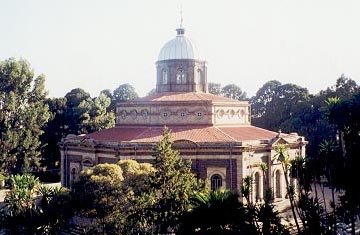
The Cathedral of St. George is located in the heart of downtown Addis Ababa, in the Arada district of the city. It is referred to often as Arada Giorgis (St. George of Arada). Emperor Menelik II dealt a crushing defeat on the forces of Italy on St. George's day in 1896 at Adowa. In gratitude to this Saint, who has served as a Patron Saint of the Empire, and of the Armed Forces, Emperor Menelik commissioned the construction of a Cathedral in his honor in the heart of Addis Ababa. The Italian prisoners of war assisted in the construction of the Cathedral among several projects that they were paid to do as their government negotiated the terms of peace and their release. The Cathedral is an octagon, in the traditional round style of many Ethiopian Churches. The Cathedral of St. George was where Empress Zewditu was crowned Empress of Ethiopia in 1917, and where Emperor Haile Selassie was crowned in 1930. An equestrian statue of Emperor Menelik II stands in Menelik Square outside the main gates of the Cathedral. It was erected by Emperor Haile Selassie on the eve of his coronation in 1930. Also at the Cathedral is a large bell which was sent as a gift from Czar Alexander III of Russia to mark the dedication of the Cathedral. The Emperor Haile Selassie attended mass at this cathedral on the anniversary of his Coronation every year, and the Cathedral was the site of the service in honor of his Silver Jubilee on November 2nd, 1955. The Emperor's remains were brought to the Cathedral for part of the funeral ceremonies on November 5th, 2000. During the Italian Fascist occupation of Ethiopia (1936-1941), an attempt was made on the life of the Italian Vice-Roy, Graziani, by two Eritreans, Abreha Deboch and Moges Asgedom. In retaliation, the fascists launched a brutal massacre in Addis Ababa known as the Yekatit 12 massacre, and during the course of this slaughter, they entered and torched the Cathedral of St. George. Although the structure of the Cathedral survived the flames, the interior was completely gutted. Following his restoration to the throne in 1941, Emperor Haile Selassie had the Cathedral restored, and new murals were painted by the famous Ethiopian artists, including Maitre Artiste Afework Tekle.
 The interior of the Cathedral of St. GeorgeShowing the Iconoclasis and a Curtained entrance to the Holy of Holies
The interior of the Cathedral of St. GeorgeShowing the Iconoclasis and a Curtained entrance to the Holy of Holies  A View of the Cathedral with the Equestrian Statue of Menelik II in the square outside it's gates.
A View of the Cathedral with the Equestrian Statue of Menelik II in the square outside it's gates.
Taeka Negest Ba-eta Le Mariam(Resting Place of Kings, the Monastery Church of the Presentation of the Virgin Mary to the Temple)Addis Ababa
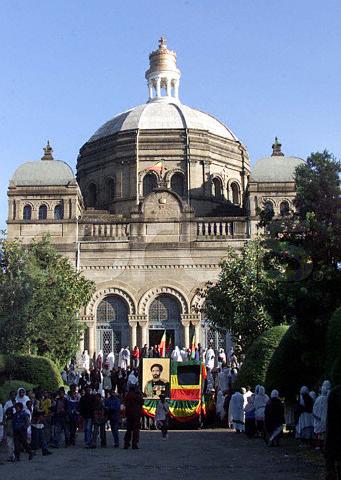 Shown on the day of the transfer of Emperor Haile Selassie's remains to Holy Trinity Cathedral, November 2000
Shown on the day of the transfer of Emperor Haile Selassie's remains to Holy Trinity Cathedral, November 2000The Taeka Negest Ba-eta Le Mariam Monastery was built in 1917 within the grounds of the Imperial Palace by Empress Zewditu of Ethiopia to house the remains of her late father, Emperor Menelik II. It is among Addis Ababa's most imposing churches. It is topped by an impressive dome which has a golden Imperial Crown at its top. Eight large stone lions guard the entrances on the four sides of the church. Emperor Menelik had died on the feast of Ba-eta Mariam, or the Presentation of the Virgin Mary to the Temple. He had been secretly buried in the Kidane Meheret Church, also in the Palace grounds, on the orders of Lij Eyasu. Empress Zewditu decided to give her father a fitting funeral in a Monastery Church dedicated to the feast day of the Holy Virgin on which he died. The church received the title "Taeka Negest" which means "Resting Place of Kings" indicating it's royal mausoleum status. While the mausoleum was being built, Menelik's widow Dowager Empress Taitu also died. Zewditu ordered that upon the completion of the Church and the tombs, her step-mother's remains be moved from her temporary grave in her neice's mausoleum tomb at Entoto Mariam Church, and laid to rest next to her husband at Taeka Negest. In 1930, Empress Zewditu herself joined them in the crypt upon her death. Zewditu arranged for the monastery church to be administered by a monk with the title "Lique Liqawint". Fitawrari Hapte Giorgis Dinagde, one of Menelik's most devoted generals, and the man who engineered the fall of Lij Eyasu, and subsequently one of the most powerful men in the Empire, was appointed the first Gebez (caretaker) of the church, a position he held for life. He had asked to be buried near his master Menelik II, but the then regent, Crown Prince Taffari Makonnen objected, saying the tomb should be limited to members of the Imperial family. The Imperial family and many noble families endowed the church generously with large grants of land estates, money, and other valuable property. During the Italian occupation, the Fascist authorities ordered the Imperial crown removed from the top of the dome of the church. It was returned to the dome following the restoration in 1941. In 1941, shortly after Emperor Haile Selassie was restored to the throne, his daughter Princess Tsehai died in childbirth. She and her infant were buried in the crypt as well. The Dergue regime apparently considered removing the crown from the dome following the 1974 revolution, but decided against it when it was pointed out they would be repeating the actions of the Fascist Italian occupiers. However, the Dergue did take over the house that had long served as the residence of the Lique Liqawint (Abbot) of the monastery and had it completely re-built as the residence of the Chairman of the Dergue(later President of the Peoples Republic) dictator Col. Mengistu Haile Mariam. It currently serves as the residence of Ethiopia's current Prime Minister. In 1991, when Emperor Haile Selassie's remains were dis-entered from the secret grave, they were initially placed in a small casket in the Crypt of Ba-eta Le Mariam Monastery, covered with a silver embroydered pall temporarily while negotiations for his permanent burial at Holy Trinity Cathedral dragged on between the government and the Imperial family. The funeral mass of the Emperor Haile Selassie was finally celebrated at Taeka Negest Ba-eta Le Mariam Monastery by the Patriarch of the Ethiopian Orthodox Church on November 5th 2000, before his remains were taken in procession to Holy Trinity Cathedral to be buried. Interior pictures posted courtesy of George Burditt(with our warmest thanks)
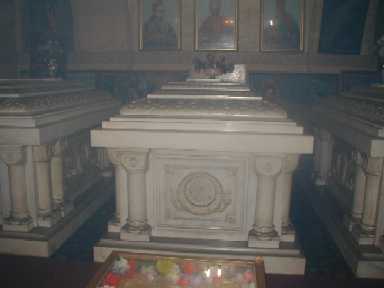 From Left to Right, Tombs of Empress Taitu, Emperor Menelik II, and Empress Zewditu
In the Crypt of Ba-eta Le Mariam Church
From Left to Right, Tombs of Empress Taitu, Emperor Menelik II, and Empress Zewditu
In the Crypt of Ba-eta Le Mariam Church.
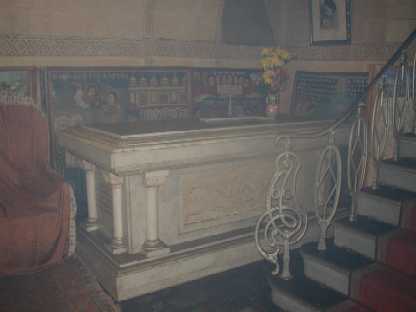 Tomb of Princess Tsehai Haile Selassie
Tomb of Princess Tsehai Haile Selassie
Kidist Mariam(St. Mary's Church)Entoto
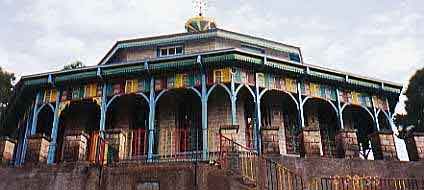
The Church of St. Mary on Mt. Entoto was built by Menelik King of Shewa and his wife Taitu shortly after their marriage in 18??. It became the principal church of the town of Entoto which served as Menelik's capital at the time. It was the site of the coronation of Menelik and Taitu as Emperor and Empress of Ethiopia in 1894. Emperor Menelik moved his capital to Addis Ababa, but he remained devoted to this church and visited it regualrly, having it constantly renovated and improved over the years. Upon his death, his widow, Empress Taitu returned to Entoto "to be near her church" and lived in the Palace nearby until her death. The Dowager Empress was initially buried in a mausoleum at this church, but her remains were moved to the Ba-eta Le Mariam Monastery upon it's completion to lie next to her husband. The church is located at the summit of eucalyptus covered Mt. Entoto overlooking Addis Ababa, and commands breath taking views of the city and the surrounding countryside. It has an interesting museum which contains various gifts from the Imperial family, the crown of Menelik II, and some of his robes of state, as well as the gold medal of olympian Haile Gebre Selassie.
The Churches of Lalibella
In the northern district of Lasta is a small town once known as Roha, now known as Lalibella, which was once capital of the Ethiopian Empire during the rule of the Zagwe dynasty. The Zagwe ruled Ethiopia between the fall of the last Axumite Emperor Anbassa Widim, and the restoration of the Solomonic Dynasty with his decendent Emperor Yekonu Amlak. In the the twelfth century, the most famous of the Zagwe Emperors, Lalibella (for whom the town was renamed) built in this spot, 11 unique and remarkable churches. His widow would later complete a 12th church. These churches are remarkable in that they were not built, but were carved out of solid rock with a high degree of detail, inside and out. The method and tools used to carve these churches is lost to history. These churches are not only a major tourist attraction, but they are also still active houses of worship, and a major site of pilgrimage, especially at Christmas time. It is said that Emperor Lalibella intended that these churches would be an alternate pilgrimage spot for people who could not make the arduous journey to Jerusalem. It is still believed by many that the blessings of a visit to Lalibella's churches will extend not only to the pilgrim, but to his or her decendents for 14 generations. Lalibella is one of several of the Zagwe Emperors to be canonized as Saints of the Ethiopian Orthodox Church.
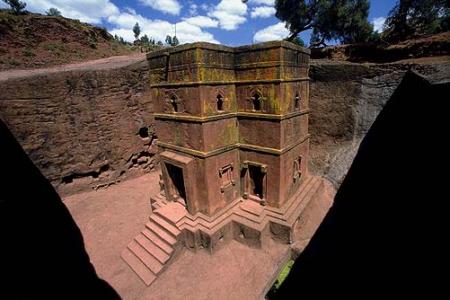 The Beite Giorgis Church (House of St. George)
Built in the shape of a Greek Cross
The Beite Giorgis Church (House of St. George)
Built in the shape of a Greek Cross
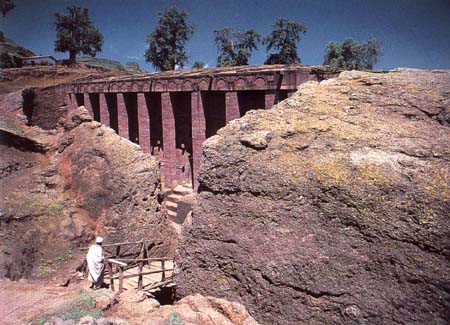 Beite Medhane Alem Church (House of the Savior of the World
The Largest of Lalibella's Rock Hewn Churches
Beite Medhane Alem Church (House of the Savior of the World
The Largest of Lalibella's Rock Hewn Churches
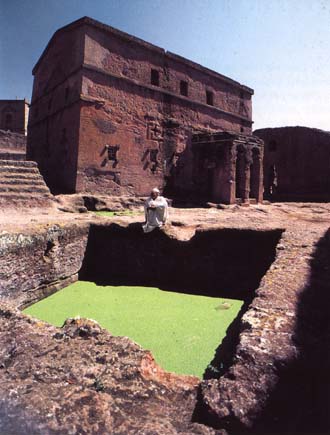 Beite Mariam Church (House of Mary)
With it's miraculous pool in the foreground
Beite Mariam Church (House of Mary)
With it's miraculous pool in the foreground
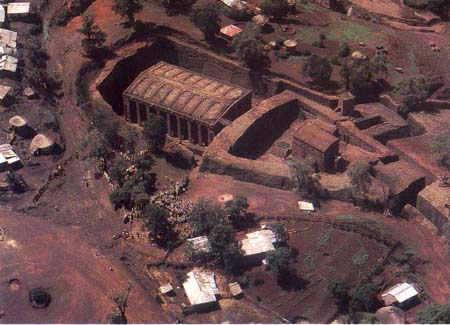 Arial view of Beite Medhane Alem and Beite Mariam Churches
Arial view of Beite Medhane Alem and Beite Mariam Churches
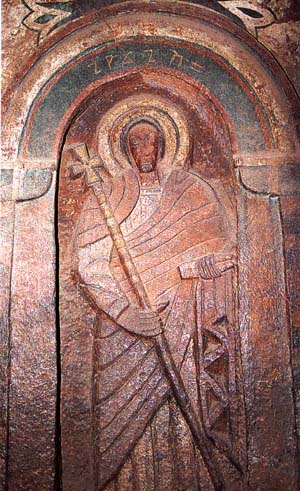 Relief of St. George in the Church of St. Merkorios at Lalibella
Relief of St. George in the Church of St. Merkorios at Lalibella
 Another of Lalibella's Rock Hewn Churches
Another of Lalibella's Rock Hewn Churches
Deeply revered in Ethiopia as a Holy Pilgrimage spot, Lalibella continues to attract thousands of Pilgrims every year as well as tourists from all over the world. Following his defeat at the hands of the fascist Italian forces at the battle of Maichew in 1936, Emperor Haile Selassie made a pilgrimage here to pray. Much work is being done today to preserve and protect the churches. Unfortunately in recent years there has been much theft of religious manuscripts, crosses and other relics from these churches, most notably the extremely revered Afro Aigeba processional cross of Emperor Lalibella, which was stolen, sold to a Belgian collector, but subsequently returned amid much rejoicing.
 Another view of the Beite Giorgis Church showing the roof which is at ground level
Another view of the Beite Giorgis Church showing the roof which is at ground level
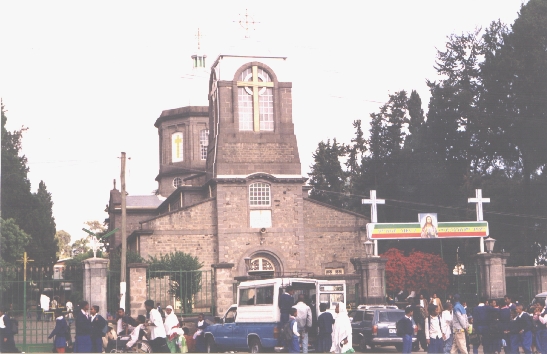 Meskea-hazunan Medhane Alem (Church of the Savior of the World, Consoler of the Bereaved), also known as Sidetegnaw (The Exiled) Medhane Alem ,Addis Ababa
Meskea-hazunan Medhane Alem (Church of the Savior of the World, Consoler of the Bereaved), also known as Sidetegnaw (The Exiled) Medhane Alem ,Addis Ababa
This church has a unique and special status among the Imperial Churches of Ethiopia. When Emperor Haile Selassie went into exile in 1936, he and his family took up residence in Fairfield House in the town of Bath, England. Both the Emperor and Empress Menen were deeply oppressed under emense sorrow at having been driven out by the Italian invasion, and were doubly grieved by the fact that there was no local Ethiopian Orthodox Church for them to turn to in their grief. The Empress made several trips to and extended stays with the Ethiopian community in Jerusalem, but the trips were expensive, and the Imperial family were in dire straights at the time financially. The Emperor then wrote a letter to the exiled Echege of Debre Libanos who was living at the Ethiopian Monastery in Jerusalem asking him to send him a tabot (replica ark of the covenant) dedicated to the Savior with two priest and deacons to establish a church in Bath. The Echege promptly did so sending the tabot of the Savior of the World (Medhane Alem) to England with the required number of clergy. The Emperor and his family set up the new church in the former dining room of Fairfield House and attended mass and prayer services here. It became known as Sidetegnaw Medhane Alem (the exiled Savior of the World). In 1941, following the restoration of Emperor Haile Selassie to his throne and the defeat of the Fascist Italian forces in Ethiopia, Empress Menen returned to Addis Ababa in early September 1941. The Tabot of Medhane Alem arrived with her. Initially a church was built on the grounds of the Haile Selassie I Hospital or Beite Saida Hospital as it was then known (presently the Yekatit 12 Hospital) to serve as the new Medhane Alem church. The Emperor bestowed the title "Meskea-hazunan" on the Church which translates as "Consoler of the Bereaved", but it continued to be refered to as Sidetegnaw "Exiled" Medhande Alem even to the present day. The church became a very popular place of worship, so the Emperor built a new church building directly across Merid Azmatch Asfaw Wossen Avenue from the main gates of the Guenete Leul Palace (presently Addis Ababa University). The Imperial family, many Princes of the Blood, and high nobles who had built their homes in the area regularly attended services at the church. The the christian students of the Ras Tafari Makonnen School for Boys and Empress Menen School for Girls attended sunday services at this church every sunday with the Imperial family. The Emperor always attended mass at this church on the morning of May 5th, the day of the Liberation and his restoration to the throne. In an incident during his last months in power, the Emperor was being driven home from the Duchess of Harrars Palace when his car was prevented from proceeding by a demonstration of anti-monarchist university students. The students were hurling vulgar insults at the Emperor, and threatening to charge on his car. He was taken from his car by his attending staff who called the custodian of the keys to the church who let the Emperor into the building while the crowd of students was cleared. Just before the Emperor entered the church, an outraged officer of the Imperial Guard asked the Emperor to give him permission to fire into the crowd of these dangerous and treasonous aggitators. The Emperor looked at the officer in horror and said "It shall never be said of me that I shed the blood of my children. It may be said of my successor, but not of me." It was an erie yet accurate prediction. The Emperor then went to his stall in the church and prayed for an hour on his knees with his face covered as the crowds were cleared by riot police outside. The priest custodian of the keys of Medhane Alem church, one of the few people present, said that when the Emperor rose to leave, his face was wet with tears. (This eyewittness report was related to the author as a young boy by this same priest, the late Abba Gerima, Gebez (caretaker and keyholder) of Medhane Alem). Emperor Haile Selassie was deposed by the Derg only a few months later.
 The Church of Debre Birhan Selassie in Gondar (Holy Trinity Mountain of Light Church)
The Church of Debre Birhan Selassie in Gondar (Holy Trinity Mountain of Light Church) The Church of the Holy Trinity in Gondar is one of the prominent churches of Gondar. It was built by Emperor Eyasu II in the 17th Century, whose nom-du-guerre was Birhan Seged (He to Whom the Light Bows). The title of "Debre Birhan" or "Mountain of Light" was bestowed on the church in honor of the Emperor's no-du-guerre as well as in honor of the Holy Church of the same name in Shewa. The Debre Birhan Church in Shewa was where a miraculous apparition of the Holy Light of God is credited to have occured in the Middle Ages during the reign of Emperor Zera Yacob the Great. Indeed, in exchange for the right of using this name, the Gondar church paid the Shewan church an annual tribute. The outside of the Church is rather plain and simple, but it is the interior that makes it one of Ethiopia's top tourist attractions. The walls are covered with paintings of saints and biblical events. The Holy Trinty and the Crucifixion have pride of place above the entrance to the Holy of Holies, and the famous ceiling is covered with the winged faces of hundreds of angels. Above the floor of the church one can see the curtained windows of the second story stall from which Emperor Eyasu II, and his mother Empress Mentewab would look down on the ceremonies. (More pics coming soon)When the Mahdist Dervishes of the Sudan sacked the city of Gondar in 1888, they burned down every church in the city except Debre Birhan Selassie, robbing Ethiopia of some of it's most remarkable architectural gems. Many credit a miracle for the saving of Debre Birhan Selassie. It is said that when the Mahdist soldiers approached the church, a swarm of bees decended on the compound of the church and kept the soldiers back, and that the Archangel Michael himself stood before the large wooden gates with a flaming sword drawn. Debre Birhan Selassie Church of Gondar is among the most significant churches of Ethiopia.
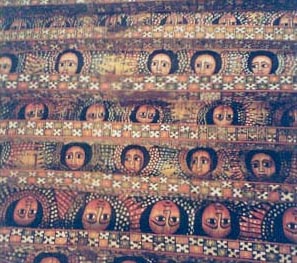 The Angelfaces on the Ceiling of the Church
The Angelfaces on the Ceiling of the Church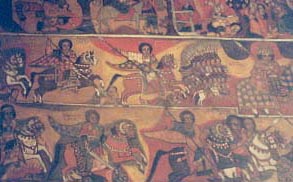 Painting of Equestrian Saints on the walls of the church
Painting of Equestrian Saints on the walls of the church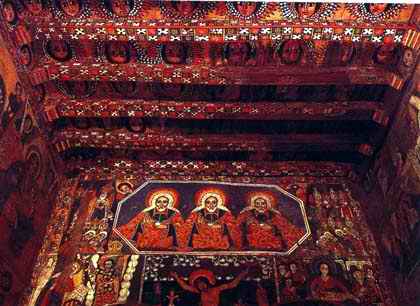 The painting of the Holy Trinity and surrounding images above the entrance to the Holy of Holies
The painting of the Holy Trinity and surrounding images above the entrance to the Holy of Holies
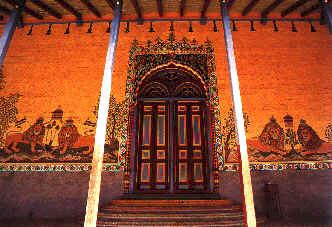 The Debre Tsion Kidist Mariam Church at Addis Alem
The Debre Tsion Kidist Mariam Church at Addis Alem
Emperor Menelik II at the turn of the 20th century decided that because of the rapidly deminishing wood supply around the capital, he would move his seat of power from Addis Ababa to Addis Alem, a new city he would build one hundred kilometers to the west. Work was started on a palace there, and the Italian embassy went so far as to build a new embassy at Addis Alem as well. However, Emperor Menelik changed his mind,(some say he had a dream that the place would bring bad fortune), and the capital remained at Addis Ababa. However, the Throne Hall that had had built to be part of the new Palace complex was turned into a church dedicated to the Virgin Mary and can be seen in the picture above. As it was named for St. Mary of Zion in Axum, the church's administrator was granted the title of Nebure Id, but he did not enjoy the same precidence as the Nebure Id at Axum at court.
Debre Guenet Kidane Meheret Monastery (Our Lady Covenant of Mercy)of Jerusalem
The Monastery of Our Lady Covenant of Mercy (Kidane Meheret) is located not in Ethiopia, but in Jerusalem. The Ethiopian Orthodox Tewahido Church has a long presence in in the Holy Land going back centuries. Indeed, the church once controled a sizable portion of the Church of the Holy Sepulcher. However, in the 19th Century, an epidemic wiped out the monks and nuns of the Ethiopian Monastery and Convent there, and as a result, much of the property was handed over to the care of the Coptic and Armenian Churches who as co-religionists of the Ethiopians were thought to be the most trustworthy. However, when replacement monks arrived, the Copts and Armenians refused to return the keys to the rooms, and the Ethiopians were relegated to a few huts on the roof of the Church of the Holy Sepulcher, known as the monastery of Der Sultan. The Coptic church has infact claimed this monastery as well, and the dispute is ongoing. To ease the hardships of the monks and nuns in Jerusalem, Emperor Yohannis IV purchased land and began work on a new church and monastery shortyl after he became Emperor of Ethiopia. Following his defeat of Egypt at the battles of Gundat and Guda-gude, the Emperor even sent the large amount of Turkish currency and gold that he had captured to help pay for the building of this monastery. After his death at the battle of Metemma, the building of the new Church and Monastery of Our Lady Covenant of Mercy (Kidane Meheret) became a favored project of both Emperor Menelik II and his wife Empress Taitu who spent considerable sums of their private money and crown funds on the completion of the church and the funding of the monastery.
 The interior of the church
The interior of the church
The Church was completed in 1897 and given the title "Debre Guenet" or "Mountain of Paradise" and continues in service to this day. It is in the traditional circular plan of many Ethiopian churches and is richley decorated with many fine icons. It has recieved the patronage of not only the Imperial family, but many of Ethiopias noble families, as often elderly noblemen and noblewomen would take vows and enter the monastery as monks or nuns in old age.
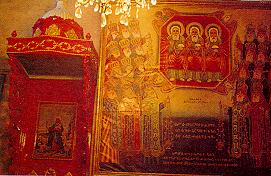 Another view of the church interior
Another view of the church interior An inside view of the church dome
An inside view of the church dome
 The Imperial Churches
The Imperial Churches

 The Imperial Churches
The Imperial Churches
